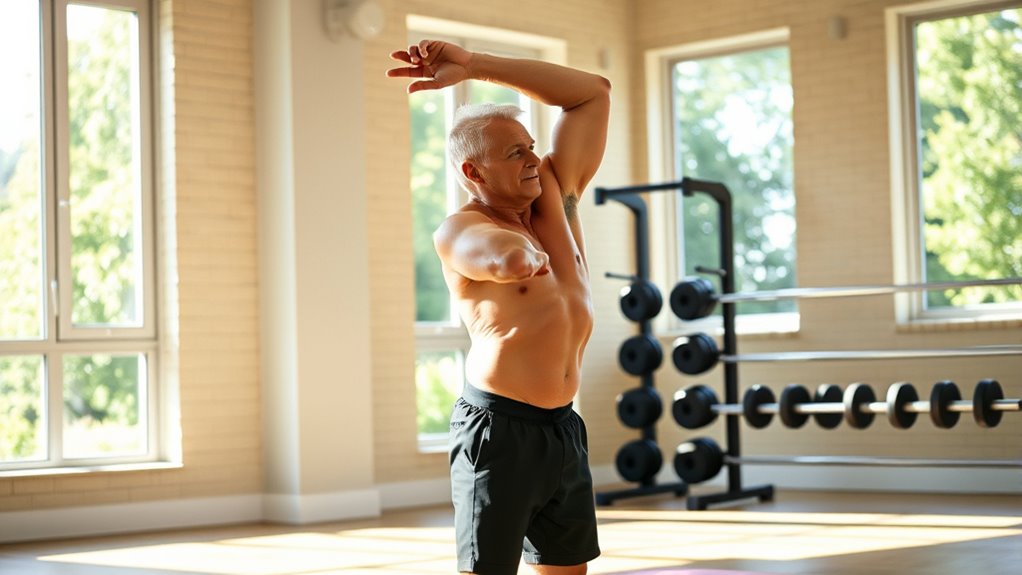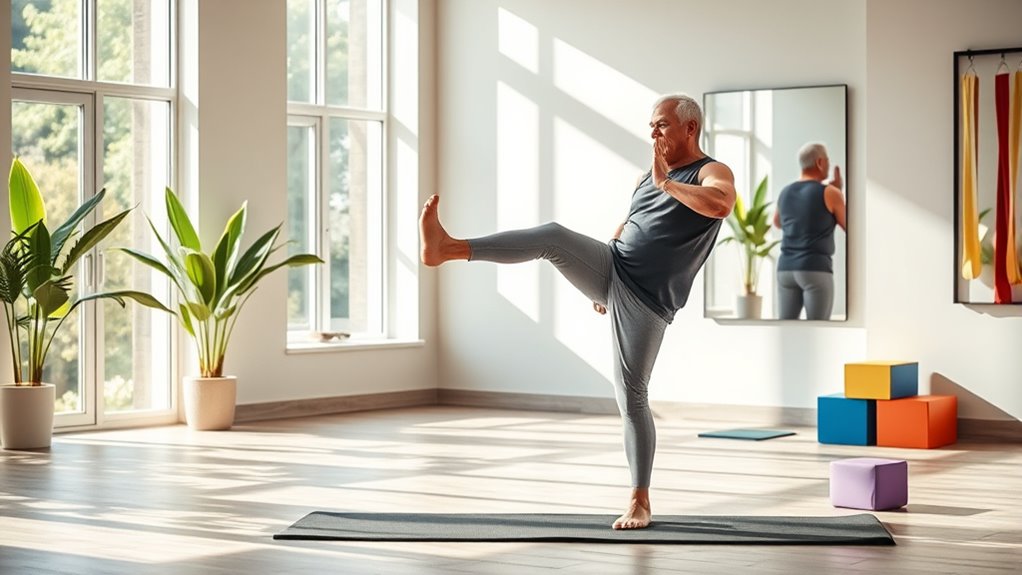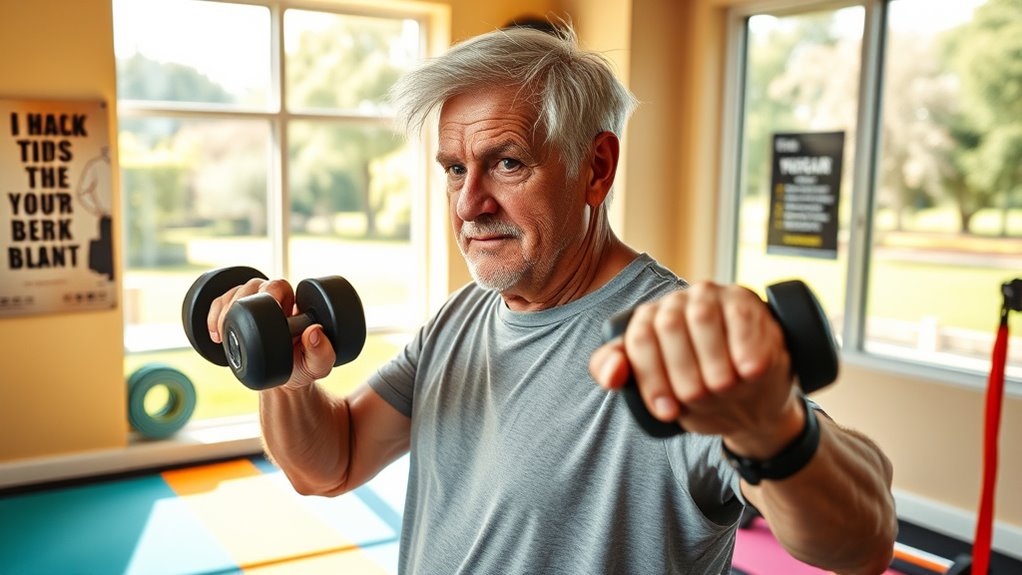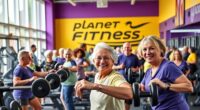To feel stronger every day, focus on a balanced workout that includes essential strengthening, stretching, and balance exercises. Incorporate resistance training like wall pushups and pelvic tilts, along with daily stretching and weight-shifting activities for improved stability. Don’t forget nutrition; aim for high protein meals for muscle recovery. Regularly track your progress and set achievable goals to stay motivated. Embracing these practices can enhance your overall well-being, and there’s more to explore to maximize your strength journey.
Key Takeaways
- Engage in resistance training exercises like wall pushups and abdominal contractions to build strength safely.
- Incorporate daily stretching routines to enhance flexibility and support mobility for everyday activities.
- Practice balance exercises, such as single-leg stands and tai chi, to improve stability and coordination.
- Ensure adequate protein intake at every meal to support muscle recovery and prevent mass loss.
- Track your progress regularly to celebrate achievements and adjust fitness goals as needed.
Change Your Mindset for Effective Training

As you age, it’s vital to shift your mindset for effective training, since your body’s work capacity and recovery can change. Prioritizing mental health is significant; focus on sleep, stress management, and nutrition to optimize your training results. Additionally, establishing a structured morning routine can set a positive tone for the day ahead and enhance your overall training effectiveness. Research shows that emotional instability can impact motivation and consistency in workouts, making mental health a crucial aspect of your fitness journey. Furthermore, staying informed about financial considerations for elderly care can alleviate stress and allow you to focus more on your fitness goals. Embracing a growth mindset can empower you to view challenges as opportunities for improvement rather than obstacles.
Rather than trying to replicate your younger workouts, embrace a smart approach tailored to your current abilities. This helps you build strength and maintain strength and balance without risking injury. Listen to your body—adapting workouts to suit your individual needs is key. A positive mindset about aging can enhance your motivation and overall health, making your workouts more effective. Additionally, strong communication skills can help you seek guidance and support from fitness professionals to maximize your training outcomes.
Essential Strengthening and Stretching Exercises

To maintain your strength and flexibility as you age, incorporating essential strengthening and stretching exercises into your routine is crucial.
Start with resistance training exercises like wall pushups and abdominal contractions to build muscle and prevent the loss of bone mass. You can easily perform these on soft surfaces like carpets or yoga mats. Regular exercise can also help reduce anxiety and depression symptoms, enhancing your emotional well-being as you age. Engaging in a consistent workout routine supports long-term strategy for maintaining overall health. Additionally, engaging in regular physical activity can help meet your dogs’ emotional needs, ensuring you both enjoy a balanced lifestyle together. Moreover, staying physically active can also assist in managing filial responsibility laws, as maintaining health can reduce potential caregiving burdens on family members.
Additionally, engage in pelvic tilts to strengthen your core and lower back, while shoulder blade squeezes support your upper back strength and posture.
Don’t forget daily stretching, as it improves your range of motion and comfort in daily activities. Simple neck stretches and ankle rotations can greatly enhance flexibility, making it easier for you to stay active and enjoy life. Regular exercise also promotes emotional well-being, which is essential as you navigate the aging process.
Balance Exercises for Fall Prevention

Incorporating balance exercises into your routine is essential for preventing falls as you age, since improved stability and coordination can greatly reduce injury risks. Additionally, environmental interactions play a crucial role in enhancing your overall physical health. Many hotels often provide access to water park amenities that can encourage physical activity in a fun setting. Engaging in regular physical activity can also lead to optimal times to cruise, where you can enjoy new experiences while staying active. Regular exercise can also help improve mental clarity, contributing to a more active and alert mind.
Start with simple movements like shifting your weight from one leg to another. Stand tall, take a deep breath, and slowly lower your foot back down. If needed, use a chair for support.
Begin with basic weight-shifting exercises, standing tall and using a chair for support if necessary.
You can also practice single-leg balances, focusing on engaging your shoulder blades. Aim for 10 to 30 seconds on each leg, and repeat daily.
Activities like tai chi or yoga can further enhance your balance and can be easily integrated into your week. Regular practice boosts your confidence in mobility, making everyday tasks easier and safer. Additionally, as seen with many actors’ careers post-success, maintaining physical fitness can open doors to new opportunities and experiences.
Nutrition Tips for Muscle Recovery

Nutrition plays an essential role in muscle recovery, especially for older men looking to maintain strength and vitality. To support this process, aim to consume 35 to 40 grams of protein per meal, incorporating a variety of protein sources like lean meats, fish, dairy, legumes, and nuts. These foods help prevent muscle mass loss and enhance recovery. Additionally, focusing on high protein intake can significantly aid in muscle repair. Regularly reviewing and adjusting your nutrition plan can also ensure you’re meeting your retirement savings goals for long-term health. Engaging in hands-on learning experiences can help improve overall cognitive function, which may contribute to better health decisions. Moreover, incorporating herbal teas like ginger and chamomile can promote relaxation and support recovery after workouts.
Hydration is equally important—dehydration can hinder muscle function and slow healing. After your workouts, include carbohydrates in your post-workout meals to replenish glycogen stores and fuel recovery.
Timing is significant, too; try to eat protein and carbohydrates within 30 minutes to two hours after exercise to maximize muscle recovery and guarantee you’re ready for your next workout. Additionally, consider incorporating high-protein breakfast ideas to kickstart your day with the nutrients your body needs for effective recovery.
Progress Tracking and Goal Setting

Tracking your progress and setting achievable goals is essential for staying motivated and focused on your fitness journey as you age. To make the most of your efforts, consider these strategies:
- Regularly track your progress in strength, endurance, and flexibility.
- Set specific goals, like exercising for 15 minutes daily or increasing protein intake.
- Use a journal or app to document workouts and feelings.
- Celebrate milestones such as completing a week of workouts or lifting heavier weights. Additionally, maintaining a balanced diet that includes freshly squeezed juices can provide essential nutrients to support your workouts. Incorporating organic fruits and vegetables into your juices ensures you’re getting the maximum health benefits.
Engaging in regular self-assessment helps you adjust your goals and strategies, ensuring they stay realistic and aligned with your fitness level. Additionally, incorporating self-care practices into your routine can support your overall well-being as you pursue your fitness objectives.
Frequently Asked Questions
What Is the Best Strength Exercise for a 70 Year Old Man?
The best strength exercise for a 70-year-old man often depends on his fitness level and health conditions.
However, squats are a fantastic choice. They engage multiple muscle groups, improve balance, and enhance functional strength.
You can start with bodyweight squats, focusing on proper form. As you progress, consider adding light weights or resistance bands.
Always listen to your body, and don’t hesitate to consult a fitness professional if you’re unsure about your routine.
What Is the 6 12 25 Rule?
The 6 12 25 Rule is a guideline designed for older adults to enhance muscle strength and endurance.
It suggests performing six sets of 12 repetitions with a weight that’s 25% of your one-repetition maximum (1RM). This approach allows you to use lighter weights while focusing on higher repetitions, which helps minimize injury risk.
Can a 70 Year Old Man Still Build Muscle?
Building muscle at 70 is like planting a garden; with the right care, it can flourish.
Yes, you can still build muscle through resistance training. Studies show you can increase strength and muscle mass, even as you age.
Focus on gradual progression and safe movements, and don’t forget to get enough protein—about 35 to 40 grams per meal.
Incorporating power training twice a week can further enhance your strength and overall health.
How Often Should a 60 Year Old Man Strength Train?
You should aim to strength train at least two days a week. This helps maintain muscle mass and overall strength.
Focus on major muscle groups during each session, using body weight, resistance bands, or light weights. Make sure to allow 48 hours of recovery for the same muscle groups to promote repair and growth.
Incorporating some power training twice a week can also boost your functional strength and help prevent muscle loss.
Conclusion
When you embrace these workouts, you’re not just building strength; you’re releasing your inner superhero! Each exercise, each stretch, transforms you into a powerhouse ready to conquer the day. Picture yourself defying age, moving with the grace of a gazelle and the strength of a bull! With proper nutrition and consistent progress tracking, you’ll not only feel stronger but unstoppable. So gear up, because every day is your chance to rewrite the rules of aging and feel invincible!









